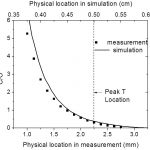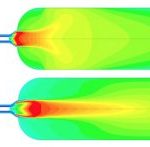More than 85 percent of the world’s energy comes from combustion. However, increasing energy demands and stricter emission regulations are introducing new challenges to the optimization of combustion processes. The Flame Design team, which involves investigators in the LACER lab as well as the University of Maryland (Peter Sunderland) and…
Read more
Biomass is an attractive source of energy: It’s renewable and has low net greenhouse emissions, because biomass growth removes CO2 from the atmosphere. However, biomass, in its raw and processed states, generally contains a considerable amount of water. For example, the broth, in the production of bioethanol from corn, contains…
Read more
Fundamental experiments on the early stages of coal combustion are important for addressing environmental and human health concerns resulting from combustion-generated aerosols. More specifically, experimental studies of coal particle ignition under conditions relevant to practical pulverized coal burners are important to provide a greater understanding of key issues, such as…
Read more
Combustion, which involves the interaction of many processes — including heat and mass transfer, chemical reaction and fluid dynamics — can be modeled with relatively high certainty using computational fluid dynamics (CFD). A properly validated CFD model can predict profiles of velocity, temperature and species concentrations, particle trajectories, pollutant formation, reaction…
Read more
In 2013, coal accounted for 29 percent of the world’s energy supply. This figure is unlikely to change substantially in the near future because coal is ubiquitous, abundant and reliable, making it a secure energy source. Unfortunately, the combustion of coal produces more carbon dioxide (CO2) per unit of energy…
Read more
The United States and several other countries are considering adopting hydrogen as a fuel carrier. Nonetheless, many challenges must be addressed before hydrogen can be used as a a transportation fuel, particularly the fire hazards that hydrogen presents if it leaks. Hydrogen has a number of unique properties that make…
Read more
When combustion occurs in normal gravity, the hot gases rise due to buoyancy and affect fluid flow and flame shape. When combustion occurs in microgravity, buoyancy effects are eliminated so there is greater control of the fluid flow. Without buoyancy, it is actually possible to achieve spherically symmetric flames and…
Read more
Temperature is among the most important measurements in reacting flow studies, as it contains information about chemistry, emissions and efficiency. And the thermocouple is the workhorse of temperature measurement, as they are inexpensive, robust and precise and can be used to measure a wide range of temperatures. Unfortunately, thermocouples also…
Read more
Pressurized oxy-combustion is a promising technology that can significantly reduce the energy penalty associated with first-generation oxy-combustion systems designed to capture CO2 in coal-fired power plants. However, higher pressure increases the production of strong acid gases — including sulfur trioxide (SO3) and nitrogen dioxide (NO2) — and aggravates the threat of…
Read more
With the rapid development of new combustion technologies, a deeper understanding of flames via advanced combustion diagnostics is required to meet society’s demand for combustion devices that operate with greater efficiency and less pollution. Laser-induced breakdown spectroscopy (LIBS) is an innovative approach to elemental analysis. We apply this technology in…
Read more











